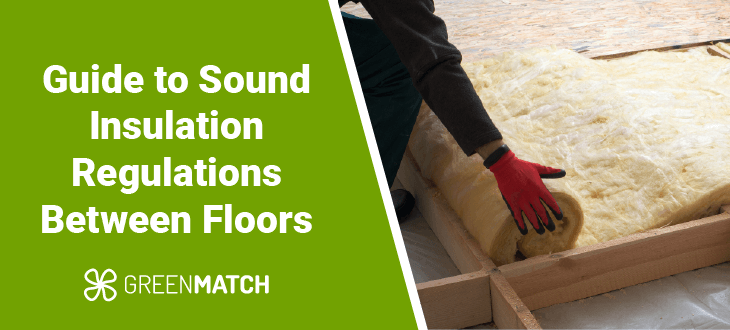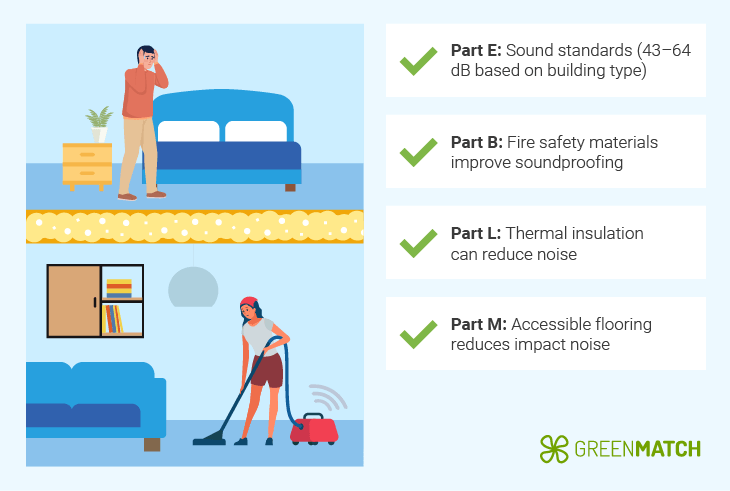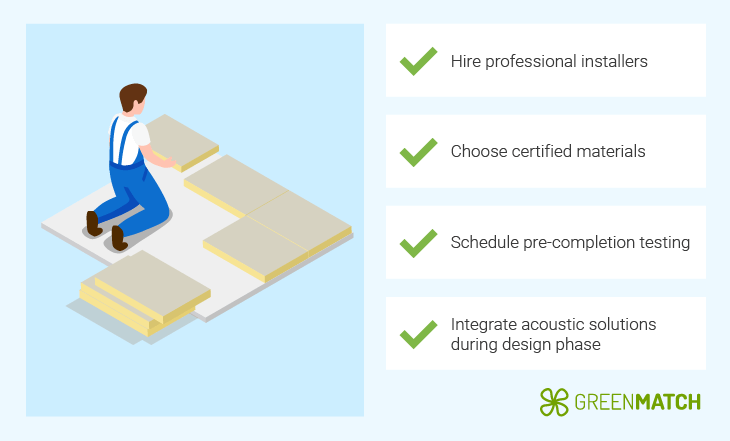Answer these simple questions and we will find you the BEST prices
Which type of solar quotes do you need?
It only takes 30 seconds
100% free with no obligation

Get Free quotes from insulation specialists near you

Save money by comparing quotes and choosing the most competitive offer

The service is 100% free and with no obligation
- GreenMatch
- Insulation
- Floor Insulation
- Regulations for Sound Insulation Between Floors
Guide to Regulations for Sound Insulation Between Floors


- Part E of the Building Regulations is the UK’s standard for controlling noise within and between buildings.
- In new residential buildings, floors must block at least 45 dB of airborne noise and keep impact noise below 62 dB.
- Pre-completion testing is needed to check that sound insulation meets Part E standards. This test must be done by an accredited professional, and results are reported to the local authority.
As more people look to improve the comfort of their homes, effective sound insulation between floors has become a top priority, especially in the UK, where noise reduction is highly valued. Over half of UK residents consider soundproofing essential when renovating, underscoring the importance of creating quieter, more enjoyable living spaces.
Installing between floor sound insulation reduces unwanted noise and contributes to energy efficiency, offering dual benefits that transform home environments.
In this guide, we’ll explain everything you need to know about the Building Regulations that affect sound insulation between floors. We’ll also explain Part E standards for soundproofing in new builds and conversions and how Parts B, L, and M also play a role. Whether you're a homeowner or a developer, our guide offers the insights and steps to ensure your project meets these critical noise control and safety standards.
Are you eager to start but need help figuring out where to begin? Ensuring your sound insulation meets building regulations is crucial—falling short can lead to costly fixes, failed inspections, and even legal issues. Skip the hassle of researching on your own—take 30 seconds to fill out our quick form, and we'll provide you with up to 3 free customised quotes from trusted professionals in our network. Click below to get started!
- Describe your needs
- Get free quotes
- Choose the best offer
It only takes 30 seconds



Building regulations for sound insulation between floors

Sound insulation between floors in multi-occupancy buildings is primarily regulated by Approved Document E of the Building Regulations, specifically designed to control noise transfer within buildings. However, other parts of the regulations—such as Part B, Part L, and Part M—can indirectly influence how sound insulation is implemented. Here’s a breakdown of each relevant part:
- Part E: Part E sets sound insulation standards for residential buildings. New floors must meet 45 dB for airborne sound and 62 dB for impact sound. For conversions, the standards are 43 dB for airborne and 64 dB for impact sound.
- Part B (Fire Safety): Fire safety regulations can affect sound insulation between floors, as they often require fire-resistant materials and compartmentalised floor construction to prevent the spread of fire. Floors built to meet fire safety requirements may use dense, fire-rated materials with sound-dampening properties, thereby enhancing sound insulation between floors. This means that, in some cases, meeting fire safety requirements can also support the goals of sound insulation.
- Part L (Conservation of Fuel and Power): Part L requires energy-efficient construction, including floor thermal insulation. Some thermal insulation materials, like high-density mineral wool, are also effective for soundproofing. Although their primary purpose is to improve energy efficiency, they can also reduce noise transmission between floors, aligning with the goals of Part E. This overlap allows for the multi-purpose use of insulation materials to meet energy and sound requirements.
- Part M (Access to and Use of Buildings): In accessible buildings, particularly those designed for people with mobility challenges, require comfortable and safe flooring for wheelchair use and reduce tripping hazards. This often involves softer or resilient flooring, which can also help reduce impact noise. By following Part M requirements, builders can incidentally improve impact sound insulation between floors, contributing to the soundproofing goals outlined in Part E.
While both soundproofing and thermal insulation are designed to improve comfort, they serve different purposes. Soundproof insulation focuses on blocking or absorbing sound waves to reduce noise transfer between spaces, making rooms quieter. On the other hand, thermal insulation for floors aims to reduce heat transfer, keeping rooms warmer in winter and cooler in summer. Although some materials can offer soundproofing and thermal benefits, each type is explicitly tailored to address either noise or temperature control.
What is Part E of the Building Regulations?
Part E of the Building Regulations, titled "Resistance to the Passage of Sound," is the UK’s government standard to control noise transmission within and between buildings. The guidelines ensure sound insulation, helping to create quieter and more comfortable living environments. Here’s a quick breakdown of what Part E covers:
- Performance standards: Part E specifies precise performance standards for sound insulation between floors and walls. These include minimum airborne sound insulation levels and maximum impact sound insulation limits. Tables provided in the document (Tables 1a and 1b) outline these values, requiring a minimum of 45 dB for airborne sound insulation and a maximum of 62 dB for impact sound insulation, as mentioned above, in new residential buildings, with slightly lower standards for conversions.
- Material change of use: The regulation includes specific guidelines for material change of use, such as converting a non-residential building into residential units. When a material change of use occurs, the building must comply with the sound insulation standards as closely as possible. However, exceptions are made for historic buildings where full compliance may not be feasible without risking the building’s integrity.
- Pre-Completion Testing (PCT): PCT is required to verify that sound insulation meets Part E standards. An accredited body must conduct this testing, and the results must be reported to the local authority. Part E also allows robust standard details (RSDs) as an alternative to PCT, provided the construction adheres to specific, pre-approved soundproofing designs.
- Acoustic conditions in schools: Part E includes special school requirements, emphasising appropriate acoustic conditions to support effective learning. The regulation references Building Bulletin 93 as the performance standard for acoustic design in schools, ensuring classrooms have adequate noise control.
- Reverberation in common areas: Part E mandates control over reverberation in shared spaces like corridors and stairwells for buildings with multiple residential units, such as flats. This measure is intended to reduce noise echoing in these common areas, enhancing overall comfort for residents.
Part E’s comprehensive approach addresses sound insulation through required testing, performance standards, and special provisions for various building uses, including schools and conversions. To explore the Building Regulation Part E more in-depth, you can access the document on the UK Government's official website.
How to ensure your between-floor sound insulation meets regulations

Achieving compliant sound insulation between floors can be challenging, but a few key steps will help you meet Part E regulations and avoid costly corrections. Here are some essential tips:
- Work with a professional installer: Professionals understand the materials, techniques, and testing requirements needed to pass inspections. Failing to comply with Part E can lead to expensive rework and delays, so expert floor insulation installation is a worthwhile investment.
- Use approved soundproofing materials: Choose materials that are certified for sound insulation, like high-density mineral wool, resilient underlays, and acoustic mats. These materials are specifically designed to reduce airborne and impact noise, helping your floors comply with minimum decibel levels.
- Plan for PCT: Pre-completion testing is a requirement for most new builds and conversions. Work with your installer to arrange this test after installation to avoid last-minute issues. Alternatively, robust standard details can bypass testing if you follow pre-approved designs that meet regulatory standards.
- Consider acoustic performance early in design: Incorporate acoustic insulation between floors into your floor design from the start. Good planning can prevent structural gaps or flaws that compromise sound insulation, ensuring that your building passes PCT on the first attempt.
Failure to comply with building regulations
As of 2024, the UK has introduced stricter penalties for not following building regulations, including Part E sound insulation standards. Under the Building Safety Act 2022, violations can result in unlimited fines with additional daily fines until compliance is achieved.
The enforcement period for non-compliant work has also been extended from 12 months to 10 years after project completion. These changes highlight the importance of meeting floor insulation building regulations to avoid serious legal and financial consequences.
Want to ensure your sound insulation fully meets regulations without the stress of going it alone? By working with trusted experts, you’ll avoid costly mistakes and rest easy knowing your project will pass inspections the first time.
Skip the hassle of researching and comparing providers—simply fill in our quick form, and you’ll receive up to 3 free quotes from trusted professionals in your area. Ensure your sound insulation is done right by professionals who are experienced in meeting the latest Part E requirements. Click below to get started!
- Describe your needs
- Get free quotes
- Choose the best offer
It only takes 30 seconds



FAQ
Yes, you can install sound insulation between floors to reduce airborne and impact noise. Building regulations, specifically Part E, outline standards and recommended materials for effective soundproofing in multi-occupancy buildings.
Under Part E, the Building Regulations set minimum sound insulation requirements between floors, requiring 45 dB for airborne sound and a maximum of 62 dB for impact sound in new buildings. Compliance can be achieved through PCT or RSDs.
For new residential buildings, floors must achieve at least 45 dB for airborne sound insulation and not exceed 62 dB for impact sound. Slightly lower standards apply to conversions.

Nicole Bea Kerr is a content writer for Greenmatch, leveraging her experience in B2B journalism and editing. She is interested in bringing more awareness to sustainability through informative narratives.
We strive to connect our customers with the right product and supplier. Would you like to be part of GreenMatch?

- Describe your needs
- Get free quotes
- Choose the best offer
It only takes 30 seconds



